- Home
- A. S. Byatt
Little Black Book of Stories Page 5
Little Black Book of Stories Read online
Page 5
His Northern Irish mother had meant him for the priesthood. He was to be her gift to God, she often said, having also decided that his elder brothers were to be teacher and republican politician, which they now were, showing, perhaps, the power of her gentle certainties. His father was himself a schoolteacher, specialising in Irish Literature, and had wanted Damian to be what he himself had not been, a true scholar, a linguist who spoke many tongues, a civilised man. Damian had tried to please both of them. They were kind and their tongues were golden. He had got as far as reading literature at University College Dublin, where he met his wife, Eleanor, who meant to be an actress, who had become since they parted a successful actress on the television. Eleanor was a good girl, and was tormented—in those distant days—by problems about contraception. She tormented Damian in turn, leaving him both over-excited and perpetually unsatisfied. They married, as a direct consequence, when she was eighteen and he was nineteen. Eleanor’s sister Rosalie was seventeen, not scholarly, and not a good girl. She once got drunk at a party, at the height of Damian’s time of over-excited frustration, and had suddenly stripped off her jumper and bra in a box-room where they were hunting for coats. She stood and stared at him, wild-eyed, wild-haired, laughing, and the great brown eyes of her large freckled breasts seemed to stare at him too. She told him not to be in a hurry. She told him her sister was a cold little fish, he hadn’t the wit to see it because he didn’t know enough women. He took her jumper and bra and made her put them back on. She went on laughing. A year later she was dead; she bled to death after a back-street abortion. In his dreams he still saw the spheres of her breasts, and the constellation of freckles, and the blind puckered brown eyes of her nipples.
HE DID NOT LOSE his faith as a consequence of her death. Nor as a consequence of its effect on Eleanor, who now wriggled away from his body as though he was going to damage or contaminate her. Nor out of any moral outrage—though he felt some—at the Church’s interference in processes he wanted to believe were human and natural. (That included contraception. Human beings were not animals. They cared for children for perhaps a third of the normal human life. They needed to have the number of children they could decently and responsibly care for. Their sexual desires were unfortunately not periodic in the way of cows and bitches. Women were perpetually on heat unless, as in the case of his wife, the heat had been turned off. It followed that contraception was natural.) He lost his faith as a result of a vision.
The vision was conventional enough, in one sense. It was a vision of Christ on the Cross—not a heavenly appearance, but the result of an unnaturally close inspection of the carving that hung in his local church, a painted wooden carving, neither good nor bad, a mediocre run-of-the-mill carving of a human body, unpleasantly suspended from nails hammered through the palms of hands neither writhing in pain nor distorted by stress, but spread wide in blessing. He thought, The anatomy is bad, the weight would rip through muscle and sinew long before the man was dead. Some crucifixes did support the feet. This one did not. They were crossed, and improbably nailed through both ankles. Some care had been taken to depict the agony of the muscles of the torso, the arms and the thighs. The gash under the heart had realistic slipperiness where it opened; unreal immobilised paint-blood spilled from it, in runnels someone had taken pleasure in varying. There were no bloodstains on the loincloth, which carefully obscured the sex. The face was stylised. Long, unlined, with downcast eyelids, closed as in sleep, and a mouth slightly opened, showing no teeth. More artistic blood had been dribbled from the clutches of the crown of thorns in the abundant shaggy hair. The dead or dying flesh—the carving was simply not good enough for him to be sure which—was creamy in colour, with pink highlights. He thought, I belong to a religion which worships the form of a dead or dying man. He realised that he did not believe and never had believed, either that the man’s bodily death had been reversed, or that he ascended into heaven, for there was no heaven, and all human descriptions of heaven made it pathetically clear that we can’t imagine it well enough to make it at all attractive as a prospect. He would not meet poor Rosalie in any such place, and he did not think he would even want to. He did not believe that this one unpleasant death had in any way cancelled out the sins of the earth: Rosalie’s wildness, the Church’s obstructiveness and bloodymindedness, his grandfathers’ deaths in bomb blasts in wartime (paternal) and peacetime (maternal). He never had believed any of it. He felt for the shape of the time—his whole life—when he would have said he believed, and was aghast to sense it like a great humming ice-box behind him, in which what he had been had kept its form, neither dead nor alive, suspended. He was a human bowed down under the weight of a man-sized ice-box.
He went on looking at the figure hanging by his hands, with outrage and then with pity. There was a man, who had been dying, and then dead. And there was an idea of who he was, which was a dream, which was a poem, which was a moral cage, which was a film over a clear vision of things. A man is his body, his body is a man.
From which it followed that Damian Becket, having straightened his back, and shaken the ice-box from his shoulders to melt he hoped, at the feet of the lifeless carving, had to concern himself with bodies. His vision had not taught him that everything was without meaning, that chaos reigned. There was order, but order was in time and space and the body. If a man— who had seen the ice-box—wanted to make sense of his life and live well, he must concern himself with the body. There were multifarious reasons why in his case it was the female body. His decision to become a medical student, at the age when he should have been about to earn his living, offended his mother and made his wife extremely angry. He was not quite sure why she was so very angry, and could not find out. Communication is much harder in intimate fear and anger than between casual companions. Silence spread into their lives. He went to London and she did not. She went to church, and he did not.
HE DISCOVERED COLOUR, at the same time as he took up the post at St. Pantaleon’s. Every time he came home, he stared at the bright forms on his walls, and worshipped the absence of God in the material staining of paint and ink.
He saw Daisy Whimple several more times during his visits to the Gynae Ward in the days before Christmas. She seemed to be the only student who had chosen to work on that ward—the take-up of the hospital offer had indeed been rather disappointing. She had made several bouquets or bundles of odd things suspended from the ceiling—children’s whirligigs, coloured feathers, plastic bubble-wrapping stitched with cut-up plastic beakers and bottles, green and blue. He could see her sitting cross-legged on the floor in the corner of the ward, wound in a coil of tape to which she was stitching plumage— hen-feathers, turkey-feathers, black feathers which shone like oil. He stopped once and asked her how all this was funded. She said oh, she had scrounged most of it. She said, if you look closely at a lot of these things—the little whirlies, the gauze flowers— you’ll see that they’re rejects, a bit torn. They look fine like this, if you don’t examine them too closely. He said he would see she got reimbursed, all the same.
“I like doing it,” she said. “It’s my pleasure.”
She said, “I’m putting the really colourful bits at the miserable end.”
“The miserable end?”
“The no-hopers. The dead babies and tied-up-tubes end. Sodding rotten luck to have to lie there and listen to other people’s kids squealing all night and not getting any sleep. I think you lot are cruel, if you want to know.”
He said, “Beds are in short supply.”
She said, with a return of the sudden venom that cut through her pale daffiness:
“I know all about that. All about that. The consultants are overworked, they have to have all their cases next to each other to get round, bad wombs next to good wombs and no-wombs mixed in. I do know about that.”
“I’m sorry,” he said. He wasn’t a man for arguing. He walked onwards. The Sister said:
“She was in here last year, you know. Abortion with compli
cations. Mr. Cuthbertson operated.”
Mr. Cuthbertson had subsequently left, after several of his patients had been discovered to have been badly handled. Damian looked a question at the Sister.
“Raging infection of the tubes. Lost an ovary.”
He did not want to appear to be prying, so dropped the question. He could look it up in the records. But there was no need for him to know the gynaecological history of Daisy Whimple, who was trailing paper garlands of sunflowers and pheasant feathers between the bed-heads of the no-hopers.
THE CHRISTMAS BABY was black twins, huge, healthy, and slow to deliver. Damian was there because there were complications, and because he liked to work on holy days and holidays. The ward, when they wheeled their patient in, was largely empty. The mothers and the no-mothers had Christmas cards on their lockers. Daisy Whimple’s decorations spun and fluttered in the draught from the double doors. Daisy Whimple was sitting at the Sister’s desk, eating a pot of strawberry yogurt. Damian said:
“I’m surprised to see you. You’ve made it all look lovely. But I thought you’d have gone home for the holiday, by now.”
“Home?” said Daisy. “No, I haven’t gone home.” She looked at him rather bleakly. “You haven’t gone home, either.”
“I was needed—”
“I’ve made myself useful in a small way,” said Daisy, looking at the Staff Nurse for confirmation. “Haven’t I?”
“You’ve been great.”
“I wasn’t criticising. I was just asking.”
He waited for her to say, “Well, you’ve asked, now sod off.” But she just bent her fragile neck over the yogurt, and ended the conversation.
HE ASKED THE STAFF NURSE, when Daisy had left, what she thought Daisy lived on. Did she have a grant, or what? The Staff Nurse said she didn’t know. She did seem to be coming in to get warm. “She hugs the radiators, when I’m not looking,” said Nurse Ogunbiyi. “And she nicks things off the lockers and the trays going back to the kitchen. I gave her that yogurt. She talks nice enough, tells you little things, but she don’t say where she lives at present, nor yet if she’s got any cash.”
ONCE OR TWICE, when the Christmas holidays were over, he thought he saw her flitting round the corners of corridors, or stepping into the lift. But he couldn’t be sure. And he was tired, and she wasn’t his business, his business was flesh, and its making, mending, and unmaking.
ON TWELFTH NIGHT the decorations were taken down by the hospital cleaners.
HE THOUGHT of Daisy Whimple again when the Hospital Art Collection Committee met in the board-room, under Sir Eli Pettifer’s Dutch painting of the anatomy lesson. There stood the doctor, stretching out the taut umbilical cord in two fastidious fingers. There lay the dead child, its belly opened like a flower, still attached to the veined medusa-like mound, which had been part of its mother. There stood the black-robed Dutchmen, looking solemnly at the painter. There, oddly, was a small boy, aged perhaps ten, also black-robed, holding up the skeleton of a child of roughly the same size as the peaceful corpse under dissection. The skull smiled; skulls always do; it was the only smile in the serious painting. Martha Sharpin, who was early for the meeting, like Damian, said to him that it was historically interesting as to whether the skeletal child was a religious memento mori or simply an anatomical demonstration. She believed it must be religious, because of the odd age of the child who held it up. Damian said that as a lapsed Catholic he wanted to believe it was simply an elegant way of presenting anatomical facts. He had a horror, he said, of the musty world of relics and bits of skin and bone which ought no longer to have meaning if their ex-inhabitants were in heaven. Martha Sharpin said he was forgetting the resurrection of the body, for one thing. And for another, the stillborn were not in heaven but in limbo, forever unbaptised.
“Are you a Catholic?”
“No,” said Martha Sharpin, “an art historian.”
Martha represented the Spice Merchants’ Foundation on the Committee. She was the Foundation’s Arts Co-ordinator, new to the job, having succeeded Letitia Holm, an elderly aesthete from the second generation of Bloomsbury. She was regarded, with approval, as “new blood” by the distinguished trustees of the Foundation, and also with suspicion, as very young, and possibly lacking gravitas. She had a Courtauld Ph.D.—her subject had been the Vanitas in seventeenth-century painting—and a subsequent qualification in arts administration. She was in her thirties, with smooth, dark, well-cut hair and a strong-featured bony face. Her skin was golden, possibly with a hint of the oriental. She had very black brows and lashes, and dark chocolate-brown eyes: she appeared to wear no make-up, and appeared to need none. She wore the usual well-cut black trouser suit, and a scarf made of some shimmering permanently pleated textile in silver-blue, pinned, with a large glass mosaic brooch, into a shape that resembled the stocks and neckties of the people in the painting. Damian Becket liked the look of her. This was the second time they had met, the second committee meeting they had both attended. She had decided he was the mover and shaker of this committee, and that she needed to get to know him. She said:
“I have to say, the installation in the entrance hall is marvellous. Makes you want to sing, which is hard, in a hospital. Letitia told me you were the one with the ideas.”
“Letitia was very helpful to me about where to buy things for myself. I buy prints. My very first was a print by Bert Irvin called Magdalen. We bought one for the second floor, too. Rushing coloured forms, with grey. I puzzled about why it was called Magdalen—being a lapsed Catholic. Irvin names his work quite arbitrarily for the roads round his studio. I like that. Grey road, rushing colours.”
“You collect?”
“I wouldn’t call it that. I buy prints. Tell me about Joseph Beuys.”
The connection seemed odd to Martha, who raised her thick brows and opened her mouth, just as the rest of the committee came in. An almoner, a nursing supervisor, the bursar, a representative from the Art College, a junior lawyer from the Spice Merchants. The Art College representative was a performance artist whose attendance and attention at the meetings were both erratic. When he spoke, which was very infrequently, he spoke in sentences like unravelling knitting, with endless dependent clauses depending on dependent clauses ending in lacunae and stuttering. Letitia Holm had disliked and despised him. She said his conversation was like his art, which consisted of a kind of hopeless-Houdini self-suspension from anything upright—lamp-posts, railway bridges, river bridges—in cradles or bags of knotted ropes of all thicknesses. Damian did not know what Martha Sharpin thought of him. He needed to find out.
The meeting wound on. Damian reported the purchase of a painting by Thérèse Oulton and the gift by an anonymous donor of some prints by Tom Phillips. The nursing supervisor reported on the scheme for ward decoration by the art students. She said there had been problems with someone trying to bring unhygienic things into the ward with the incubators. And some of the students had started things and not come back, leaving bits of mistletoe and oranges with cloves, cluttering the Surgical Ward. Damian Becket said he thought the decoration of the Gynae Ward had been very successful, very imaginative and unusual. He thought they should thank Miss Whimple. He asked Joey Blount, the performance artist, if he knew Miss Whimple. Not personally, said Joey Blount. Not at all, actually.
The meeting always ended with the problem of Eli Pettifer’s Collection, which was always deferred. It was a condition of the bequest—and of all Pettifer’s other munificent bequests—that the Collection should be maintained and appropriately displayed. And there it was, in boxes, and old display cabinets you couldn’t make your way between. Daunting. They’d once had a real cataloguer, said the Bursar, who had been in there for six months, and got very depressed by the dust and the darkness. She turned out to have catalogued one box when she left, according to a system no one could make head or tail of. Moreover, she’d developed a mystery virus, which she claimed must have come out of the boxes, and had threatened to sue the hospi
tal.
Martha asked whether the Collection was labelled. Yes, said the Bursar, most of it had little hand-written stickers and tags. It was hard to know where to start, he said gloomily. Martha said she would like to see it. The Bursar said this was more than Letitia had offered to do. Letitia was squeamish. Martha said she herself was not, and would take a look at what was there. Damian said he would be happy to show her round.
So Damian Becket and Martha Sharpin made a clanking descent in the steel cage into the bowels of the hospital. The door to the Collection was opened by a coded keyboard: Damian punched in his code and pushed it open. Martha Sharpin exclaimed at the extent of it. There were several rooms, opening off a central one which had a little murky daylight from a thick glass window let into the pavement above, through which they could see the soles of passing feet. There were rooms within rooms, made of crates and packing-cases. There were cabinets along the walls of the rooms containing shelf after shelf of medical implements and curiosities. Martha walked along, staring in. Damian followed her. Shelf after shelf after shelf of syringes: cartridge syringes, laryngeal syringes, varicose vein syringes, haemorrhoid syringes, lachrymal syringes, exhausting syringes, made from ivory and ebony, brass and steel. From another cabinet shelf after shelf of glass eyes stared at them from neatly segmented boxes, or squinnied higgledy-piggledy, like collections of marbles. There were bottles—ancient tear-bottles, ornate pharmacy bottles in pale rose with gilded letters, preserving jars, specimen jars. There were surgical and gynaecological implements, repeated, repeated. Saws and vices, forceps and tweezers, stethoscopes, breast-pumps and urinary bottles. Shelves of artificial nipples, lead and silver, rubber and bakelite. Prostheses of all kinds, noses, ears, breasts, penises, wooden hands, mechanical hands, wire feet, booted feet, artificial buttocks, endless faded hair, in coils, in tangles, in envelopes with the names of the dead men and women from whom it had been clipped. There were specimens also. Human brains and human testicles in jars of formaldehyde. Shelves of foetuses, monkeys, armadillos, rats, sows, boys, girls and an elephant. Monsters also, humans and creatures born with no head, or two heads, stunted arms or spare fingers, conjoined twins and wizened hair-balls. One case, which was arranged with some aesthetic intention, contained a series of nineteenth-century glass ornamental domes—or maybe museum exhibits— in which foetal skeletons were at play with wreaths of dried flowers, wax grapes, skeleton leaves and branches of dead coral. Others contained wax humans divided vertically, fleshed and clothed on the left hand, polished skeleton and skull on the right. Martha lingered over these. She had seen similar things, but never so many, never so strange. Damian pulled open a tall crate from which woodshavings were emerging. Inside was what looked like a white statue of a goddess, a young woman with closed eyes and a curiously flaccid surface, folds of flesh rolling back towards her spine. He realised that she should be lying on her back, and saw that she was swollen to bursting, a full-term gravid woman. Then he bent to read the label, and saw that what he was seeing was the plaster cast made from the body of one Mercy Parker. He remembered that such plaster casts were made for teaching purposes. The deliquescent flesh was the other side of rigor mortis.

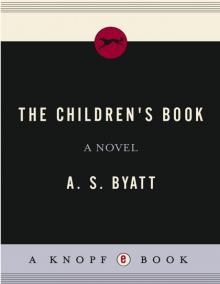 The Children's Book
The Children's Book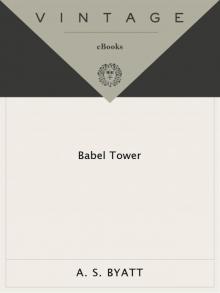 Babel Tower
Babel Tower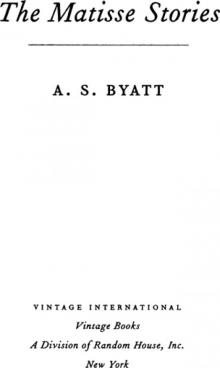 The Matisse Stories
The Matisse Stories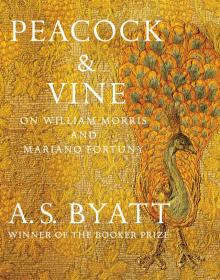 Peacock & Vine: On William Morris and Mariano Fortuny
Peacock & Vine: On William Morris and Mariano Fortuny Elementals: Stories of Fire and Ice
Elementals: Stories of Fire and Ice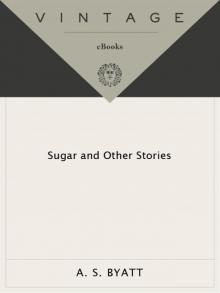 Sugar and Other Stories
Sugar and Other Stories Possession
Possession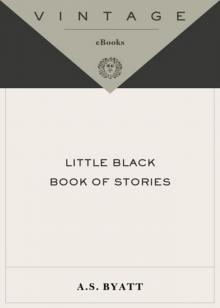 Little Black Book of Stories
Little Black Book of Stories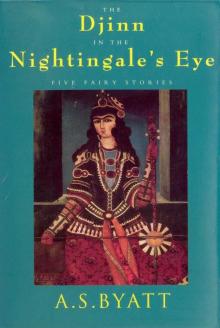 The Djinn in the Nightingale's Eye
The Djinn in the Nightingale's Eye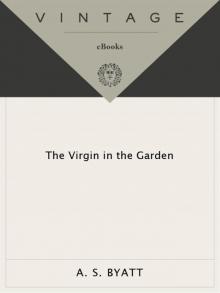 The Virgin in the Garden
The Virgin in the Garden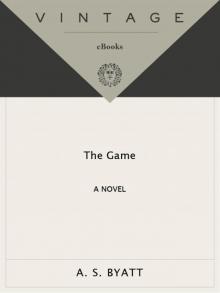 The Game
The Game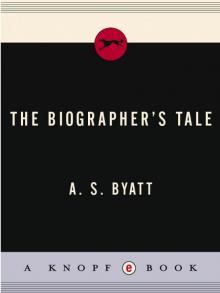 The Biographer's Tale
The Biographer's Tale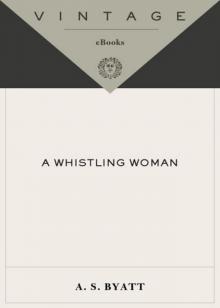 A Whistling Woman
A Whistling Woman Ragnarok
Ragnarok Angels & Insects: Two Novellas
Angels & Insects: Two Novellas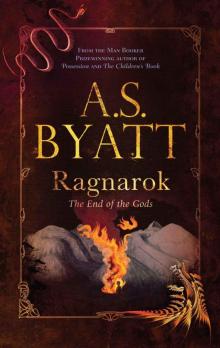 Ragnarok: the End of the Gods (Myths)
Ragnarok: the End of the Gods (Myths) Peacock & Vine
Peacock & Vine The Djinn in the Nightingale's Eye (Vintage International)
The Djinn in the Nightingale's Eye (Vintage International)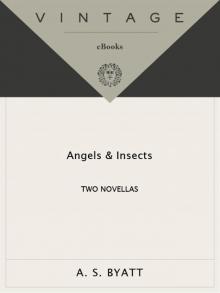 Angels and Insects
Angels and Insects The Arabian Nights: Tales from a Thousand and One Nights (Modern Library Classics)
The Arabian Nights: Tales from a Thousand and One Nights (Modern Library Classics) Elementals
Elementals